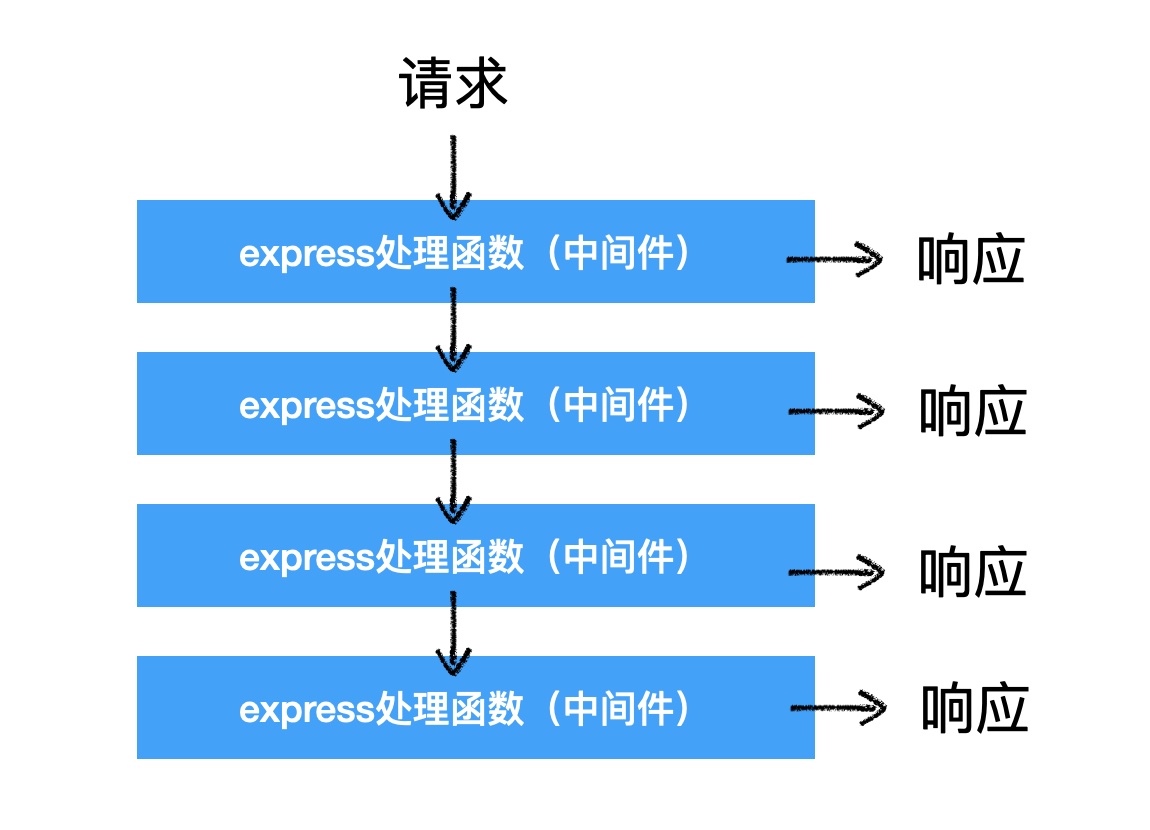
正常的响应
- 当匹配到了请求后,交给第一个函数进行处理 ```javascript
const express = require(‘express’); const app = express();//创建一个以express应用,app实际上是一个函数,用于处理请求的函数 app.get(‘/news’, (req, res, next) => { console.log(‘handle1’); next(); }, (req, res) => { console.log(‘handle2’); next(); })
app.get(‘/news’, (req, res, next) => { console.log(‘handle3’); })
app.listen(12306, () => { console.log(‘server on 12306 has started’) })
- 函数中需要手动交给后续的中间件(手动调用next)- 如果后续已经没有中间件,express会相应404- 如果中间件发生了错误,不会停止服务器,相当于调用了next(错误对象),寻找后续处理错误中间件,如果没有则响应500```javascriptconst express = require('express');const app = express();//创建一个以express应用,app实际上是一个函数,用于处理请求的函数app.get('/news', (req, res, next) => {console.log('handle1');res.sendStatus('200');res.end();next();}, (req, res) => {console.log('handle2');rs.send('aa'); // 上一个中间件已经响应请求,此处不允许响应next();})app.get('/news', (req, res, next) => {console.log('handle3');})app.listen(12306, () => {console.log('server on 12306 has started')})
如果某个中间件已经处理响应,以上代码中的
res.sendStatus('200');res.end();
后续的中间件就不再次响应,不能使用send向客户端发送响应,但是后续中间件依然会被调用
异常的相应
const express = require('express');const app = express();//创建一个以express应用,app实际上是一个函数,用于处理请求的函数app.get('/news', (req, res, next) => {console.log('handle1');// throw new Error('abc')// 相当于throw new Error('abc')next(new Error('abcd'));}, (err,req, res,next) => { // 异常响应的第一个参数是errconsole.log('handle2')})app.get('/news', (req, res, next) => {console.log('handle3');})app.listen(12306, () => {console.log('server on 12306 has started')})
中间件本质
中间件本身是一个函数,用来处理请求,
- 自定义一个处理错误中间件 ```javascript
module.exports = (err, req, res, next) => { console.log(req.baseUrl) // 匹配路径的基地址 if (err) { const errobj = { code: 500, msg: err instanceof Error ? err.message : err } // 发生了错误 res.status(500).send(errobj) } else { next(); } }
2. 使用```javascriptconst express = require('express');const app = express();//创建一个以express应用,app实际上是一个函数,用于处理请求的函数app.get('/news', (req, res, next) => {console.log('handle1');// res.sendStatus('200');// res.end();// throw new Error('abc')// 相当于throw new Error('abc')next(new Error('abcd'));})app.get('/news', (req, res, next) => {console.log('handle3');})app.use('/news', require('./errMiddleware')); // 使用中间件app.use(require('./errMiddleware')) // 处理所有的错误请求app.listen(12306, () => {console.log('server on 12306 has started')})
- 响应指定错误请求:
app.use('/news', require('./errMiddleware')); - 响应所有错误请求
:app.use(require('./errMiddleware')
自定义一个处理静态资源的中间件
定义
module.exports = (req, res, next) => {if (req.baseUrl.startsWith('api')) {next();} else {// 说明你想要的是静态资源if (true) {res.send('静态资源'); // 请注意,此处并未向后移交后续中间件} else {next();}}}
使用 ```javascript
const express = require(‘express’); const app = express();//创建一个以express应用,app实际上是一个函数,用于处理请求的函数 app.use(require(‘./staticMiddleware’)) app.get(‘/news’, (req, res, next) => { console.log(‘handle1’); // res.sendStatus(‘200’); // res.end(); // throw new Error(‘abc’)
// 相当于throw new Error('abc')next(new Error('abcd'));
}, (req, res) => { console.log(‘handle2’) })
app.get(‘/news’, (req, res, next) => { console.log(‘handle3’); }) app.use(‘/news’, require(‘./errMiddleware’)); // 使用中间件 app.use(require(‘./errMiddleware’)) // 处理所有的错误请求 app.listen(12306, () => { console.log(‘server on 12306 has started’) }) ```
- 响应所有的静态资源请求
app.use(require('./staticMiddleware'))

